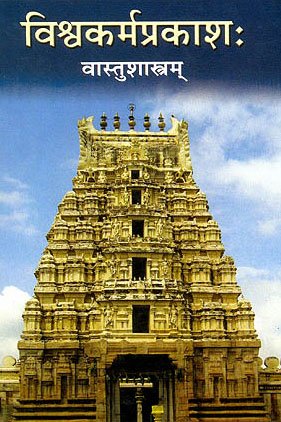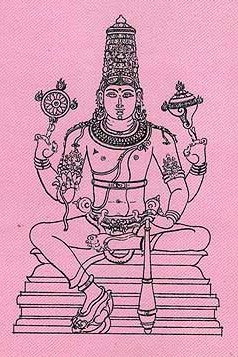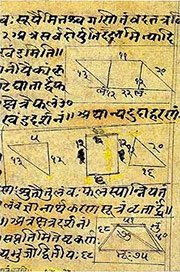Bhuti, Bhūti, Bhūtī, Bhuṭī: 22 definitions
Introduction:
Bhuti means something in Buddhism, Pali, Hinduism, Sanskrit, Marathi. If you want to know the exact meaning, history, etymology or English translation of this term then check out the descriptions on this page. Add your comment or reference to a book if you want to contribute to this summary article.
In Hinduism
Vastushastra (architecture)
Source: Wisdom Library: Vāstu-śāstraBhūti (भूति) refers to a type of temple (prāsāda) classified under the group named Maṇika, according to Samarāṅgaṇasūtradhāra chapter 49. The Maṇika group contains ten out of a sixty-four total prāsādas (temples) classified under five prime vimānas (aerial car/palace), which were created by Brahmā for as many gods (including himself). This group represents temples (e.g. Bhūti) that are to be globular and oblong in shape. The prāsādas, or ‘temples’, represent the dwelling place of God and are to be built in towns. The Samarāṅgaṇasūtradhāra is an 11th-century encyclopedia dealing with various topics from the Vāstuśāstra.

Vastushastra (वास्तुशास्त्र, vāstuśāstra) refers to the ancient Indian science (shastra) of architecture (vastu), dealing with topics such architecture, sculpture, town-building, fort building and various other constructions. Vastu also deals with the philosophy of the architectural relation with the cosmic universe.
Purana and Itihasa (epic history)
Source: archive.org: Shiva Purana - English TranslationBhūti (भूति) refers to “ashes (for smearing the body)”, according to the Śivapurāṇa 2.3.43 (“Description of Śiva’s wonderful sport”).—Accordingly, as Brahmā narrated to Nārada: “[...] O sage, on seeing the innumerable Gaṇas, Bhūtas and Pretas, Menakā was terribly frightened instantaneously. On seeing Śiva in their midst, the mother of Pārvatī trembled. She saw Śiva who though devoid of attributes was better than those who had all the attributes, He was seated on the Bull. He had five faces and three eyes. He had ashes smeared over the body (bhūti-bhūṣita). [...]”.
Source: Cologne Digital Sanskrit Dictionaries: The Purana Index1a) Bhūti (भूति).—A son of Yuyudhāna and father of Yugandhara.*
- * Brahmāṇḍa-purāṇa III. 71. 101; Vāyu-purāṇa 96. 100.
1b) The mother of Bhautya.*
- * Brahmāṇḍa-purāṇa IV. 1. 51.
1c) A Śakti.*
- * Brahmāṇḍa-purāṇa IV. 44. 74.
1d) A son of Bhautya; the future Manu.*
- * Matsya-purāṇa 9. 35; Vāyu-purāṇa 100. 55.
1e) A Sādhya; destroyer of all Asuras.*
- * Matsya-purāṇa 171. 44.
1f) Gave birth to Bhūtas, followers of Rudra.*
- * Vāyu-purāṇa 69. 242.
1g) The wife of Pulastya.*
- * Viṣṇu-purāṇa I. 7. 7.

The Purana (पुराण, purāṇas) refers to Sanskrit literature preserving ancient India’s vast cultural history, including historical legends, religious ceremonies, various arts and sciences. The eighteen mahapuranas total over 400,000 shlokas (metrical couplets) and date to at least several centuries BCE.
Kavya (poetry)
Source: archive.org: Naisadhacarita of SriharsaBhūti (भूति) refers to a supernatural power, and is mentioned in the Naiṣadha-carita 21.160.—The eight well-known Bhūtis of a Yogin are indirectly mentioned in the verse.
The Bhūtis are:
- aṇimā,
- mahimā,
- garimā,
- laghimā,
- īśatva,
- vaśitva,
- prākāmya,
- kāmāvasāyitā (kāmāvasāyitva).
In certain lists prāptī is substituted for garimā, and the bhūtis or siddhis, as they are called, are also somewhat differently explained. Cf. Mārkaṇḍeyapurāṇa 40.31-33. Sāṃkhyatattvakaumudī explains nine siddhis, both garimā and prāpti being included. It explains prākāmya as “icchanabhighāta[?]”. The eight siddhis are referred to in Prabodhacandrodaya 3.22 and explained in detail in the Candrikā commentary, which, however, omits kāmāvasāyitva and includes both garimā and prāpti.

Kavya (काव्य, kavya) refers to Sanskrit poetry, a popular ancient Indian tradition of literature. There have been many Sanskrit poets over the ages, hailing from ancient India and beyond. This topic includes mahakavya, or ‘epic poetry’ and natya, or ‘dramatic poetry’.
Shaktism (Shakta philosophy)
Source: Google Books: ManthanabhairavatantramBhūti (भूति) (or Subhūti) and Sarveśvara refers to the pair of Goddess and God appearing in the eighth Kalpa (aeon), according to the Kularatnoddyota.—Chapter nine of the Kularatnoddyota opens with the goddess asking how the Kula tradition (kulāmnāya) will be worshipped along with its mantras and Vidyās and who will bring it down (avatāraka) into the world in the various cosmic aeons (kalpa). After explaining that it is brought down into the world by incarnations or aspects of both the god and the goddess (aṃśamātra), the god goes on to list the names of these aspects—a goddess and her consort [i.e., Subhūti—Sarveśvara]—in nineteen aeons (kalpa), many of which we recognize from the earlier version in the Tantrasadbhāva.—(cf. Jayadrathayāmala-tantra of the Kāpālikas).

Shakta (शाक्त, śākta) or Shaktism (śāktism) represents a tradition of Hinduism where the Goddess (Devi) is revered and worshipped. Shakta literature includes a range of scriptures, including various Agamas and Tantras, although its roots may be traced back to the Vedas.
Pancaratra (worship of Nārāyaṇa)
Source: University of Vienna: Sudarśana's Worship at the Royal Court According to the AhirbudhnyasaṃhitāBhūti (भूति) refers to “wealth”, according to the Ahirbudhnyasaṃhitā, belonging to the Pāñcarātra tradition which deals with theology, rituals, iconography, narrative mythology and others.—Accordingly, “The King shall obtain territory, victory, wealth (bhūti), a long life and freedom from diseases. A King who regularly worships shall conquer this whole earth, with her seven divisions and her garment of seas”.

Pancaratra (पाञ्चरात्र, pāñcarātra) represents a tradition of Hinduism where Narayana is revered and worshipped. Closeley related to Vaishnavism, the Pancaratra literature includes various Agamas and tantras incorporating many Vaishnava philosophies.
Ganitashastra (Mathematics and Algebra)
Source: archive.org: Hindu MathematicsBhūti (भूति) represents the number 8 (eight) in the “word-numeral system” (bhūtasaṃkhyā), which was used in Sanskrit texts dealing with astronomy, mathematics, metrics, as well as in the dates of inscriptions and manuscripts in ancient Indian literature.—A system of expressing numbers by means of words arranged as in the place-value notation was developed and perfected in India in the early centuries of the Christian era. In this system the numerals [e.g., 8—bhūti] are expressed by names of things, beings or concepts, which, naturally or in accordance with the teaching of the Śāstras, connote numbers.

Ganitashastra (शिल्पशास्त्र, gaṇitaśāstra) refers to the ancient Indian science of mathematics, algebra, number theory, arithmetic, etc. Closely allied with astronomy, both were commonly taught and studied in universities, even since the 1st millennium BCE. Ganita-shastra also includes ritualistic math-books such as the Shulba-sutras.
Shaivism (Shaiva philosophy)
Source: Google books: Genesis and Development of TantraBhūti (भूति) or “well- being” refers to one of the various objectives expected of the Kāmyeṣṭis (“Vedic rituals following the basic pattern of the new and full-moon sacrifice”).—There is a certain group of Vedic rituals which are referred to as “kāmya”. Those which are performed following the basic pattern of the new and full-moon sacrifice are called kāmyeṣṭi. [...] According to the analysis of W. Caland, the objectives expected of the kāmyeṣṭis are: [e.g., well- being (bhūti)] [...], etc. (Cf. Caland 1908: VI–VII). Although Vedic rituals were a reliable way for the people of ancient India to fulfill their objectives, Tantric rites too claim to bring about the attainment of wishes.

Shaiva (शैव, śaiva) or Shaivism (śaivism) represents a tradition of Hinduism worshiping Shiva as the supreme being. Closely related to Shaktism, Shaiva literature includes a range of scriptures, including Tantras, while the root of this tradition may be traced back to the ancient Vedas.
In Buddhism
Tibetan Buddhism (Vajrayana or tantric Buddhism)
Source: academia.edu: The Structure and Meanings of the Heruka Maṇḍala1) Bhūtī (भूती) is the name of a Ḍākinī who, together with the Vīra (hero) named Bhūta forms one of the 36 pairs situated in the Agnicakra, according to the 10th century Ḍākārṇava chapter 15. Accordingly, the agnicakra refers to one of the three divisions of the saṃbhoga-puṭa (‘enjoyment layer’), situated in the Herukamaṇḍala. The 36 pairs of Ḍākinīs [viz., Bhūtī] and Vīras are red in color; they each have one face and four arms; they hold a skull bowl, a skull staff, a small drum, and a knife.
2) Bhūtī (भूती) and Bhūta also form one of the 36 pairs situated in the Cittacakra, according to the same work. Accordingly, the cittacakra refers to one of the three divisions of the nirmāṇa-puṭa (‘emanation layer’), situated in the Herukamaṇḍala. The 36 pairs of Ḍākinīs [viz., Bhūtī] and Vīras are black in color; they each have one face and four arms; they hold a skull bowl, a skull staff, a small drum, and a knife.
Note: Bhūtī’s name is Bhūtini in Jayasena’s Ratnapadmarāganidhi (D 1516, 30 v 4)

Tibetan Buddhism includes schools such as Nyingma, Kadampa, Kagyu and Gelug. Their primary canon of literature is divided in two broad categories: The Kangyur, which consists of Buddha’s words, and the Tengyur, which includes commentaries from various sources. Esotericism and tantra techniques (vajrayāna) are collected indepently.
Languages of India and abroad
Marathi-English dictionary
Source: DDSA: The Molesworth Marathi and English Dictionarybhūti (भूति).—f S Superhuman power, as attributable to Shiva especially, and as attainable by the practice of austere and magical rites. 2 Greatness, grandeur, majesty. 3 Birth or production.
Source: DDSA: The Aryabhusan school dictionary, Marathi-Englishbhūti (भूति).—f Superhuman power. Greatness. Birth.
Marathi is an Indo-European language having over 70 million native speakers people in (predominantly) Maharashtra India. Marathi, like many other Indo-Aryan languages, evolved from early forms of Prakrit, which itself is a subset of Sanskrit, one of the most ancient languages of the world.
Sanskrit dictionary
Source: DDSA: The practical Sanskrit-English dictionaryBhūti (भूति).—f. [bhū-ktin]
1) Being, existence.
2) Birth, production.
3) Well-being, welfare, happiness, prosperity; प्रजानामेव भूत्यर्थं स ताभ्यो बलिमग्रहीत् (prajānāmeva bhūtyarthaṃ sa tābhyo balimagrahīt) R.1.18; नरपतिकुलभूत्यै (narapatikulabhūtyai) 2.75; स वोऽस्तु भूत्यै भगवान् मुकुन्दः (sa vo'stu bhūtyai bhagavān mukundaḥ) Vikr.1.2.
4) Success, good fortune.
5) Wealth, riches, fortune; विपत्प्रतीकारपरेण मङ्गलं निषेव्यते भूतिसमुत्सुकेन वा (vipatpratīkārapareṇa maṅgalaṃ niṣevyate bhūtisamutsukena vā) Kumārasambhava 5.76.
6) Grandeur, dignity, majesty.
7) Ashes; भृतभूतिरहीनभोगभाक् (bhṛtabhūtirahīnabhogabhāk) Śiśupālavadha 16.71 (where bhūti means 'riches' also); स्फुटोपमं भूतिसितेन शंभुना (sphuṭopamaṃ bhūtisitena śaṃbhunā) 1.4.
3) Decoration of elephants with coloured stripes; भक्तिच्छेदैरिव विरचितां भूतिमङ्गे गजस्य (bhakticchedairiva viracitāṃ bhūtimaṅge gajasya) Meghadūta 19.
9) The superhuman power attainable by the practice of penance or magical rites; सूक्ष्मात् सूक्ष्मतमोऽणीयान् शीघ्रत्वं लघिमागुणः । महिमाशेषपूज्यत्वात् प्राप्तिर्नाप्राप्यमस्य यत् ॥ प्राकाम्यस्य व्यापित्वादीशित्वं चेश्वरो यतः । वशित्वाद्वशिमा नाम योगिनः सप्तमो गुणः ॥ यत्रेच्छा स्थानमप्युक्तं यत्र कामावसायिता (sūkṣmāt sūkṣmatamo'ṇīyān śīghratvaṃ laghimāguṇaḥ | mahimāśeṣapūjyatvāt prāptirnāprāpyamasya yat || prākāmyasya vyāpitvādīśitvaṃ ceśvaro yataḥ | vaśitvādvaśimā nāma yoginaḥ saptamo guṇaḥ || yatrecchā sthānamapyuktaṃ yatra kāmāvasāyitā) || Mārk. P.4.31-33.
1) Fried meat.
11) The rutting of elephants.
-tiḥ m.
1) An epithet of Śiva.
2) Of Viṣṇu.
3) Of a class of Manes.
Source: Cologne Digital Sanskrit Dictionaries: Edgerton Buddhist Hybrid Sanskrit DictionaryBhūti (भूति).—name of a brahman, father of Subhūti (2): Avadāna-śataka ii.127.12.
Source: Cologne Digital Sanskrit Dictionaries: Shabda-Sagara Sanskrit-English DictionaryBhūti (भूति).—f.
(-tiḥ) 1. Power, dignity. 2. Superhuman power, as attributable to Siva especially, and attainable by the practice of austere and magical rites. 3. Prosperity, success. 4. Production, birth. 5. Ashes. 6. Fried meat. 7. The rut of elephants. 8. State of being, &c. 9. Wealth, riches, fortune. 10. Welfare. 11. Decoration of elephant, with coloured stripes. E. bhū to be, aff. ktin .
Source: Cologne Digital Sanskrit Dictionaries: Benfey Sanskrit-English DictionaryBhūti (भूति).—[bhū + ti], f. 1. State of being. 2. Production, birth. 3. Prosperity, [Pañcatantra] iii. [distich] 131; personified, [Rāmāyaṇa] 3, 52, 27. 4. Wealth, [Mānavadharmaśāstra] 3, 59. 5. Power, dignity. 6. Superhuman power, as attainable by the practice of austere and magical rites. 7. The rut of elephants. 8. A decoration of elephants, consisting in many-coloured stripes, [Meghadūta, (ed. Gildemeister.)] 19 (Sch.; read maṇḍanam and gajamaṇḍanam instead of maṇḍalam). 9. Ashes. 10. Fried meat.
Source: Cologne Digital Sanskrit Dictionaries: Cappeller Sanskrit-English DictionaryBhūti (भूति).—[feminine] being, [especially] well-being, welfare, wealth, fortune; ornament, decoration.
--- OR ---
Bhūti (भूति).—[feminine] being, [especially] well-being, welfare, wealth, fortune; ornament, decoration.
Source: Cologne Digital Sanskrit Dictionaries: Monier-Williams Sanskrit-English Dictionary1) Bhūti (भूति):—[from bhū] bhūti or ([Ṛg-veda]) bhūti, f. existence, being, [cf. Lexicographers, esp. such as amarasiṃha, halāyudha, hemacandra, etc.]
2) [v.s. ...] wellbeing, thriving, prosperity, might, power, wealth, fortune, [Ṛg-veda] etc. etc.
3) [v.s. ...] Welfare personified (= lakṣmī), [Bhāgavata-purāṇa]
4) [v.s. ...] superhuman power (as attainable by the practice of austerity and magical rites), [Horace H. Wilson]
5) [v.s. ...] ornament, decoration, [Meghadūta 19]
6) [v.s. ...] ashes, [Kāvya literature; Kathāsaritsāgara]
7) [v.s. ...] fried meat, [cf. Lexicographers, esp. such as amarasiṃha, halāyudha, hemacandra, etc.] (?)
8) [v.s. ...] = bhūmi, earth, ground, [Aitareya-brāhmaṇa] ([Sāyaṇa])
9) [v.s. ...] (with marutām) Name of a Sāman, [Ārṣeya-brāhmaṇa]
10) [v.s. ...] of various plants (Andropogon Schoenanthus or = rohiṣa etc.), [cf. Lexicographers, esp. such as amarasiṃha, halāyudha, hemacandra, etc.]
11) [v.s. ...] (also tī), of the wife of Ruci or Kavi and the mother of Manu Bhautya, [Harivaṃśa; Viṣṇu-purāṇa]
12) [v.s. ...] m. a class of deceased ancestors, [Mārkaṇḍeya-purāṇa]
13) [v.s. ...] Name of Viṣṇu, [Mahābhārata]
14) [v.s. ...] of Śiva, [cf. Lexicographers, esp. such as amarasiṃha, halāyudha, hemacandra, etc.]
15) [v.s. ...] of the father of Manu Bhautya, [Mārkaṇḍeya-purāṇa]
16) [v.s. ...] of a Brāhman, [cf. Lexicographers, esp. such as amarasiṃha, halāyudha, hemacandra, etc.]
Source: Cologne Digital Sanskrit Dictionaries: Yates Sanskrit-English DictionaryBhūti (भूति):—(tiḥ) 2. f. Dignity, power; superhuman power sought by magic; prosperity; birth; state; ashes, fried meat.
Source: DDSA: Paia-sadda-mahannavo; a comprehensive Prakrit Hindi dictionary (S)Bhūti (भूति) in the Sanskrit language is related to the Prakrit word: Bhūi.
[Sanskrit to German]
Sanskrit, also spelled संस्कृतम् (saṃskṛtam), is an ancient language of India commonly seen as the grandmother of the Indo-European language family (even English!). Closely allied with Prakrit and Pali, Sanskrit is more exhaustive in both grammar and terms and has the most extensive collection of literature in the world, greatly surpassing its sister-languages Greek and Latin.
Kannada-English dictionary
Source: Alar: Kannada-English corpusBhūti (ಭೂತಿ):—
1) [noun] the state or fact of being; existence.
2) [noun] an act or instance of being born; birth.
3) [noun] a successful, flourishing or thriving condition; prosperity.
4) [noun] a great quantity or store of money, valuable possessions, property or other riches; wealth.
5) [noun] favorable opinion or judgement; respect or regard; esteem.
6) [noun] the powdery residue of matter that remains after burning; ash.
7) [noun] a decorative stripe or stripes painted on an elephant.
8) [noun] any of the super human accomplishment got by austerities or yogic practices.
9) [noun] roasted meat.
10) [noun] Śiva.
11) [noun] Viṣṇu.
Kannada is a Dravidian language (as opposed to the Indo-European language family) mainly spoken in the southwestern region of India.
See also (Relevant definitions)
Starts with (+31): Bhutibali, Bhutibhana, Bhutibhushana, Bhutibhushita, Bhutida, Bhutidatta, Bhutidiksha, Bhutigarbha, Bhutigauri, Bhutijya, Bhutika, Bhutikah, Bhutikala, Bhutikalasha, Bhutikama, Bhutikarman, Bhutikes, Bhutikila, Bhutikirtana, Bhutikrit.
Ends with (+108): Abadhutanubhuti, Abhibhuti, Abhuti, Adisambhuti, Advaitanubhuti, Agnibhuti, Akhadabhuti, Akhandanubhuti, Amoghabhuti, Ananubhuti, Anubhuti, Apabhuti, Aparokshanubhuti, Aprabhuti, Aryamabhuti, Asahanubhuti, Asamavibhuti, Asambhuti, Ashadhabhuti, Ashta-bhuti.
Full-text (+159): Agnibhuti, Brahmabhuti, Bhutikritya, Sarvatmabhuti, Bhutigarbha, Bhutinidhana, Meghabhuti, Viyadbhuti, Rangabhuti, Bhutisrij, Bhutikama, Bhutikarman, Bhutikala, Bhutishvaratirtha, Bhutyartham, Bhutikila, Devabhuti, Subhuti, Bhavabhuti, Bhautya.
Relevant text
Search found 55 books and stories containing Bhuti, Bhūti, Bhūtī, Bhuṭī; (plurals include: Bhutis, Bhūtis, Bhūtīs, Bhuṭīs). You can also click to the full overview containing English textual excerpts. Below are direct links for the most relevant articles:
The Markandeya Purana (Study) (by Chandamita Bhattacharya)
3. Worship and Mythology of Agni < [Chapter 3]
Superstitions Related to New Born Babies < [Chapter 2]
Rig Veda (translation and commentary) (by H. H. Wilson)
The backdrop of the Srikanthacarita and the Mankhakosa (by Dhrubajit Sarma)
Part 5q - Alaṃkāra (17): Vibhāvanā or peculiar causation < [Chapter III - Literary Assessment Of The Śrīkaṇṭhacarita]
Part 8 - Impact of previous poets upon Maṅkhaka < [Chapter III - Literary Assessment Of The Śrīkaṇṭhacarita]
Early Chola Temples (by S. R. Balasubrahmanyam)
Temples in Kodumbalur < [Chapter IV - Temples of Sundara Chola’s Time]
Parantaka I < [Chapter XIV - Conclusion]
Temples in Andanallur (14th year) < [Chapter X - Historical Survey]
The Vishnu Purana (by Horace Hayman Wilson)
Chapter II - Of the seven future Manus and Manvantaras < [Book III]
Chapter XIV - Dynasty of Anamitra and Andhaka < [Book IV]
Garga Samhita (English) (by Danavir Goswami)
Verse 4.2.7 < [Chapter 2 - The Story of the Gopīs That Had Been Sages]